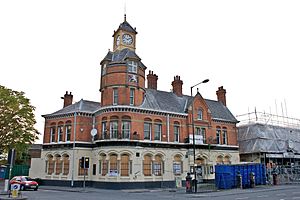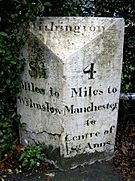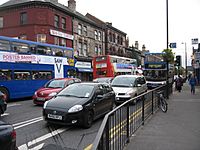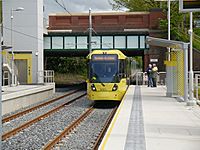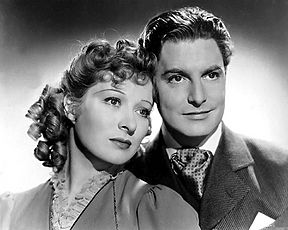Withington facts for kids
Quick facts for kids Withington |
|
|---|---|
 Withington village centre viewed from Wilmslow Road |
|
| Area | 2.7 sq mi (7.0 km2) |
| Population | 13,422 (2011 Census) |
| • Density | 5,218/sq mi (2,015/km2) |
| OS grid reference | SJ848929 |
| • London | 160 miles (257 km) SE |
| Metropolitan borough | |
| Metropolitan county | |
| Region | |
| Country | England |
| Sovereign state | United Kingdom |
| Post town | MANCHESTER |
| Postcode district | M20 |
| Dialling code | 0161 |
| Police | Greater Manchester |
| Fire | Greater Manchester |
| Ambulance | North West |
| EU Parliament | North West England |
| UK Parliament |
|
Withington is a lively suburb in Manchester, Greater Manchester, England. It's about 4 miles (6.4 km) south of Manchester city centre. Withington has a population of around 13,422 people, based on the 2011 census.
Historically, Withington was part of Lancashire. In the early 1200s, it was a large feudal estate. This estate included several nearby areas like Chorlton-cum-Hardy and Didsbury. It was mainly a farming area for many centuries.
In the mid-1800s, Withington changed a lot. The Industrial Revolution in Manchester caused it to grow quickly. More people moved there, and it became a busy urban area. Withington officially became part of the City of Manchester in 1904.
Today, Withington is home to many different people. You'll find families, university students, and young professionals living here. This is partly because it's close to big universities like the University of Manchester. Withington is also known for its medical facilities. It has the Christie Hospital, which is one of Europe's largest cancer treatment centers.
Contents
Discovering Withington's Past
How Withington Began
In ancient Anglo-Saxon times, Withington was a quiet place with few people. The name Wīðign-tūn means "willow-copse farmstead." This tells us it was a farm near willow trees.
By the early 1200s, Withington was a sub-manor of the larger Manor of Manchester. The first Lord of the Manor was likely William, son of Wulfrith de Withington. The area was much bigger back then, covering many of the surrounding towns we know today.
The Hathersage and Longford families were important lords of Withington for over 300 years. They were granted special rights to hunt in the area.
From Tudor Times to Georgian Era
In the late 1500s, the Mosley family bought Withington. They were wealthy wool merchants. Sir Nicholas Mosley built Hough End Hall in 1596. This grand house became the new manor house for Withington. The original medieval manor house was surrounded by a moat. Today, only small parts of this moat remain.
In the early 1700s, the Egerton family of Tatton bought Withington. The village grew along Wilmslow Road. This was a main road connecting Manchester to Wilmslow. Farming was still very important. Some historians believe "Cotton Lane" got its name from shared farming land.
Victorian Growth and Modern Changes
As Manchester grew in the 1800s, so did trade and traffic in Withington. Turnpike roads, where you paid to use the road, became unpopular and were stopped in 1881. Cheaper transport helped Withington grow even more.
The Withington and West Didsbury railway station opened, connecting people to Manchester Central railway station. This station closed to passengers in 1961.

Many churches were built as the population increased. St Paul's Parish Church was built in 1841. A new church school, St Paul's Primary School, opened in 1844.
A famous composer, Felix Mendelssohn, visited Withington in the 1840s. He stayed with the Souchay family, who were important residents. Mendelssohn even played the new pipe organ at St Paul's Church. Sadly, this was his last visit to Britain before he passed away.
In 1861, Withington opened a public library and village hall. The library was rebuilt in 1927 with a new look.
Aviation History in Withington
Withington has a special place in aviation history. On April 28, 1910, French pilot Louis Paulhan landed his plane in Barcicroft Fields. This was near the borders of Withington. He had just completed the first powered flight from London to Manchester. Paulhan won a £10,000 prize from the Daily Mail.
Later, a large airfield called Alexandra Park Aerodrome was built in 1917. It was located on what is now Houghend Playing Fields. This airfield closed in 1924.
How Withington is Governed
Withington was once a separate township. In 1881, Withington Town Hall was built to manage the local area. Withington officially became part of the City of Manchester in 1904. The old Town Hall building is now private apartments.
Withington is part of the Manchester Withington area for national elections. This area includes Withington village and nearby places like Chorlton-cum-Hardy. People in this area vote for a MP to represent them in the UK Parliament.
For local matters, Withington has its own councillors. These councillors represent the area on the Manchester City Council. They help make decisions about local services and issues.
People of Withington
Withington is a diverse place. Most residents are White British, but there are also people from various other backgrounds, including Irish, Asian, and Black communities. The area has a mix of ages, with many students due to the nearby universities.
Withington's Location
 |
Whalley Range | Fallowfield | Fallowfield |  |
| Chorlton-cum-Hardy | Burnage | |||
| West Didsbury, Northenden | Didsbury | Heaton Mersey |
Withington is located about 4 miles (6.4 km) south of Manchester city centre. It sits in the middle of the Greater Manchester Urban Area.
Important Places in Withington
Withington has several historic buildings. Many are "Grade II listed," meaning they are important and protected.
- Hough End Hall (1596): This was the old Withington Manor House.
- Manchester and County Bank (1890): Now a restaurant.
- St Paul's Parish Church (1841): A beautiful historic church.
- Red Lion Inn (17th century): A very old pub.
- White Lion public house (1841): Another historic pub, now a shop.
Other interesting places include:
- Christie Hospital: Founded in 1892, it moved to Withington in 1932. It's famous for cancer research and treatment. It pioneered X-Rays for therapy in 1901.
- Scala Cinema (1912–2008): This was Manchester's oldest cinema. It's now being redeveloped.
- Milestone: Outside the fire station, it shows distances to Wilmslow and Manchester.
- The Water Trough (1876): A stone drinking trough for horses, with an old Bible verse.
- Withington Library (1927): A lovely building designed by Henry Price.
- Marcus Rashford mural: A famous painting by Akse P19.
Getting Around Withington
Buses in Withington
Withington has excellent bus connections. It's on the Wilmslow Road bus corridor, which is one of the busiest bus routes in Europe. Many buses run frequently, connecting Withington to Manchester city centre and other areas.
Trams in Withington
The Manchester Metrolink tram system now serves Withington. The old railway line was reopened as a light rail line in 2013. You can catch a tram from Withington tram stop to reach Manchester city centre and other places. The tram stop is about 1 mile (1.6 km) from the very center of Withington.
Schools and Learning in Withington
Withington has several schools.
- Withington Girls' School: A private school for girls aged 7 to 18, established in 1890.
- Manchester Grammar School: A well-known boys' school that moved nearby in the 1930s.
Local primary schools include:
- Ladybarn Primary School
- St Cuthbert's Roman Catholic Primary School
- St Paul's Church of England Primary School
- Mauldeth Road County Primary School
- St Kentigern's Roman Catholic Primary School
- Old Moat School
Nearby secondary schools include The Barlow RC High School and Didsbury High School.
Notable People from Withington
Many famous people have connections to Withington:
- Robert Donat: An Academy Award-winning actor, born in Withington in 1905. He starred in Goodbye, Mr. Chips.
- Alan Erasmus: Co-founder of Factory Records and the Haçienda, a famous music venue.
- Martin Lewis: The financial expert behind MoneySavingExpert.com, was born here.
- John Mahoney: An actor known for his role in Frasier, lived in Withington.
- Ernest Rutherford: A Nobel Prize-winning scientist who pioneered the orbital theory of the atom. He lived in Withington between 1898 and 1910.
- Ludwig Wittgenstein: A famous Austrian philosopher, had lodgings in Withington in 1911 while studying.
- Kate Richardson-Walsh: A gold medal-winning Team GB hockey player, was born in Withington.
- Oliver Cookson: The founder of Myprotein, was born in Withington hospital.
Images for kids




